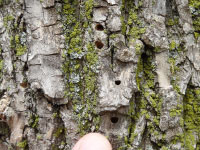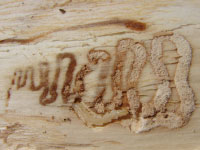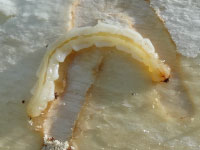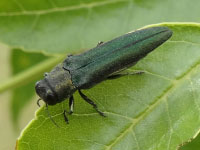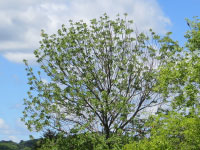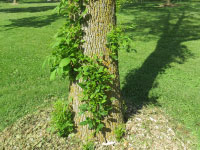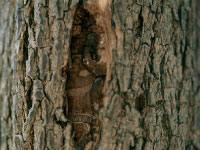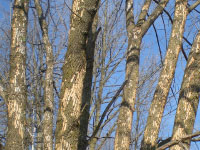Emerald Ash Borer
Signs and Symptoms
Emerald ash borer (Agrilus planipennis) is an invasive, wood-boring beetle that kills ash trees (Fraxinus spp.) by eating the tissues under the bark. Native to northeastern Asia, emerald ash borer (EAB) was first detected in the United States in 2002 and is thought to have been introduced from China via the wood from shipping crates.
EAB has been found in all 72 counties of Wisconsin. See where it has been found in the United States. Use the interactive map on the EAB portal to see if EAB has been found in your community and learn how to report new detections.
Signs and symptoms
It is important to look for at least two signs or symptoms when trying to figure out if EAB is in an ash tree because some symptoms can look like those caused by other pests and diseases.
Symptoms are the characteristics expressed by an infested tree, such as crown die-back and epicormic sprouting (growth that emerges from dormant buds along the trunk and branches). Signs are the physical evidence of the pest or disease, including larval galleries, exit holes and all life stages of the insect.
As adults emerge from under the bark they create a D-shaped exit hole that is about 1/8-inch in diameter.
As larvae feed under the bark they wind back and forth, creating serpentine galleries packed with frass, or the digested woody materials created by wood-boring insects.
Larvae are cream-colored, slightly flattened (dorso-ventrally) and have pincher-like appendages at the end of their abdomen. Fully grown, they reach about 1.5-inches in length.
Adult beetles are metallic green and about the size of one grain of cooked rice (3/8- to 1/2-inch long and 1/16-inch wide). The best time to see an adult EAB is a warm, sunny afternoon when they are likely to be either mating or laying eggs on the trunks of ash trees.
Crown dieback is a result of larval feeding, which disrupts the flow of nutrients and water to the upper canopy. Trees typically show thinning of leaves at the top of the tree within one to three years of infestation, followed by individual branch and tree death.
Epicormic Sprouting: When trees are stressed or sick, they will try to grow new branches and leaves wherever they still can. Trees may have new growth at the base of the tree and on the trunk, often just below where the larvae are feeding.
Bark Splits: Vertical splits in the bark are caused due to callus tissue that develops around larval galleries. Larval galleries can often be seen beneath bark splits.
Woodpecker flecking: Woodpeckers pick away at the outer bark of infested trees in search of nutritious larvae beneath the bark. This "flecking" usually begins higher in the tree where EAB tends to attack first. Once a tree becomes heavily infested, flecking may be seen all the way down its trunk and branches.
Ash trees
An estimated 898 million ash trees are in Wisconsin's forest lands as part of northern hardwood, oak-hickory and bottom-land hardwood forests. Ash species represent 7.8% of all trees in Wisconsin’s forests (counting all live trees 1 inch in diameter or larger). Black ash is the most common ash species and represents 4% of total tree density. White and green ash represent 2% and 1.8% of total tree density, respectively. Read more about Wisconsin’s ash resource [PDF].
EAB attacks all native species of ash in Wisconsin, including white, green, black and blue ash. While other woody plants, such as mountain ash and prickly ash, have “ash” in their names, they are not true ash species and therefore are not susceptible to attack by EAB.
True ash trees provide many ecological benefits. Their seeds provide food for birds and small mammals; black ash twigs and leaves provide food for deer and moose; and trunk cavities provide nesting areas for birds such as the wood duck. Ash is also valuable to Native Americans for its excellent basket-making quality and cultural importance.
Ash in Wisconsin's urban forests
There are an estimated 104,000 ash trees in Wisconsin’s urban and community forests. This accounts for 14.7% of all trees reported in community tree inventories provided to the DNR. Green and white ash are the most common ash species in these settings, making up 11.2% and 2.6% of total street trees, respectively. Other ash species include black, blue and European ash, which together account for a combined 0.8% of all street trees.
Black ash
Black ash (Fraxinus nigra) [PDF] can be found throughout the state, with the highest densities occurring in northern Wisconsin. This species prefers wet sites, such as riparian areas and swamps, and forest cover types, such as bottomland hardwoods, swamp hardwoods and swamp conifers. Currently, black ash is not very commercially important. However, it is valued by Native Americans due to its ability to split along growth rings, resulting in thin strips for making baskets, chair seats and barrels.
Green ash
Green ash (Fraxinus pennsylvanica var. lanceolata) [PDF] is found throughout the state but is most common in southern Wisconsin. It grows in stands with green ash or in combination with black ash, red maple, silver maple, swamp white oak and elm. It is a component of upland hardwood stands but grows most commonly in and around stream banks, floodplains and swamps. Green ash wood is not as straight-grained as white ash and thus not as commercially desirable.
White ash
White ash (Fraxinus americana) [PDF] grows on a variety of sites but is most frequently found on fertile, well-drained upland sites in both the northern and central hardwood forest types. White ash typically grows as part of other forest cover types and is rarely the dominant species. With its white, strong, straight-grained wood, it is the most commercially important ash species in Wisconsin. It is also valued for its high elasticity, shock resistance and low shrinkage.
Blue ash
Blue ash (Fraxinus quadrangulata) is the least common ash species in Wisconsin with a range limited to southern Wisconsin, particularly Waukesha County. It is listed as a threatened species in Wisconsin and is on the edge of its North American range here. It has inner bark that was used as a blue dye by Native Americans giving the species its common name. The species likes rich limestone hills but grows well on fertile bottom lands. Because of its small size and scattered distribution, blue ash is not commercially important.

